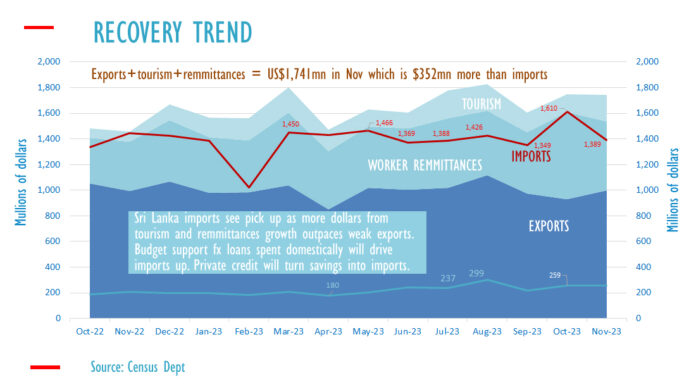[ad_1]
ECONOMYNEXT – Sri Lanka’s central bank has won the go ahead from political authorities to generate inflation up to 7 percent though an agreement signed with President Ranil Wickremesinghe as Finance Minister under a new monetary law.
The inflation target has been set with the Minister of Finance under a new Monetary Law that has allowed explicit macro-economic policy involving targeting potential output (printing money for growth).
“The Central Bank of Sri Lanka Shall aim to maintain quarterly headling (sic) inflation rate at the target of 5 percent,” an agreement made with President Ranil Wickremesinghe as Finance Minister has said.
“For the purpose of Section 26(5) of the Central Bank Act, the margin is ±2 percentage points.”
“Quarterly headline inflation rate” refers to the simple average of the year – on – year percentage changes in the monthly CCPI for the three months of the corresponding quarter.
The Sri Lanka’s central bank had on its own set a 5 percent (12-month) inflation target for many years.
The agreement allows the central bank to inflate the economy up to 7 percent.
Inflation of 7 percent allows bureaucrats to slash real salaries of the people, as well as savings of retirees and older people or capital available for investment by businesses, by the same amount.
Inflation hurts the poorest most, slashes savings of retirees and also reduces real savings available for businesses and the government, triggering foreign borrowings and makes any kind of long-term planning difficult.
The 5 percent inflation target is about 2.5 percent annual the rate found in countries with monetary stability which are now mostly developed nations and some East Asian nations and dollarized regions.
Singapore, the country which Sri Lankans hope to emulate, has generally maintained inflation below key OECD countries, using exchange rate based policy.
Sri Lanka’s central bank has since the end of the war has printed sufficient money under cover of a 5 percent inflation target to trigger currency crises in 2011/12, 2015/16, 2018 and 2020/2023.
Money is usually printed to target potential output.
Sri Lanka and Pakistan has the worst central banks in the region, triggering serial currency crises and bringing the respective countries to the brink or actual external default as well as social unrest.
Before the IMF’s Second Amendment which allowed un-elected economic bureaucrats (supported by the agency in some cases) to choose second or third rate monetary anchors and depreciate currencies at will, Sri Lanka had the same inflation as the US, though forex shortages emerged after the central bank was set up as money was printed to suppress rates and later to re-finance credit programs.
Along with the rise in inflation, interest rates also edged up and stabilization programs that follows interest rate suppression or potential output targeting then led to steep spikes in interest rates.
Similar inflation targets or slightly higher and similar types of monetary regimes are found in most countries hit by external default. (Colombo/Dec31/2023)
[ad_2]
Source link


